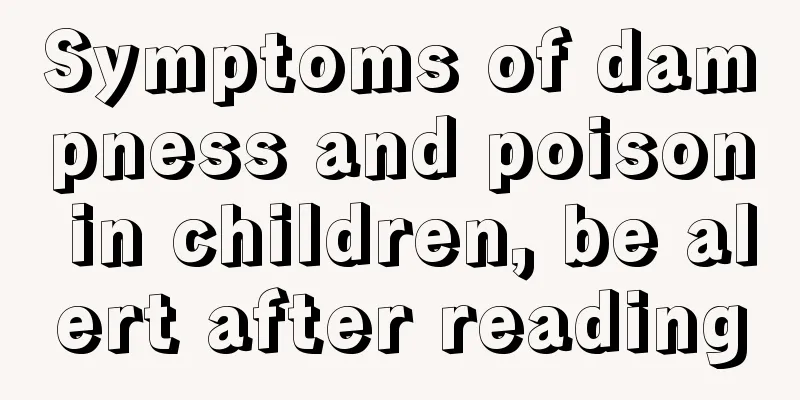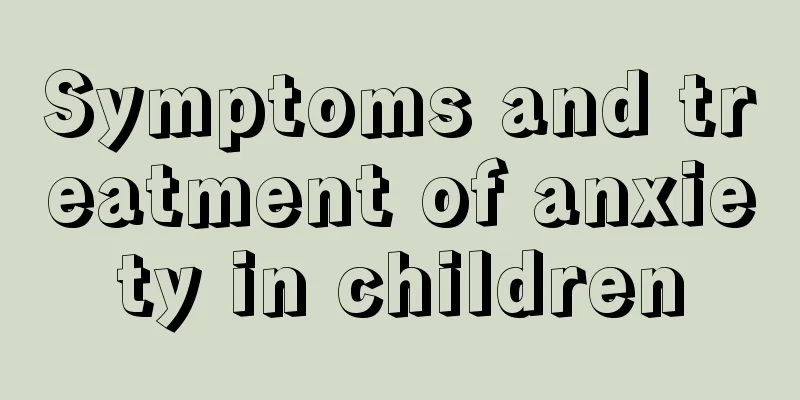Symptoms of dampness and poison in children, be alert after reading

|
The disease of dampness and poison in the little baby is not common, so many parents often ignore it, but this will harm the baby's health. Therefore, parents must understand the symptoms of this disease. Only in this way can they discover the disease in time and understand it early and treat it early. 1. Acute eczema: The skin lesions initially appear as numerous dense millet-sized papules, papulovesicles or small blisters with a flushed base, which gradually merge into flakes. Due to scratching, the tops of the papules, papulovesicles or blisters may be scratched to reveal obvious punctate exudates and small erosive surfaces with unclear edges. If secondary infection occurs, the inflammation will be more obvious and may form pustules, pus scabs, folliculitis, furuncles, etc. The patient feels severe itching, which is common on the head, face, behind the ears, distal extremities, scrotum, and perianal area, and is often distributed symmetrically. 2. Subacute eczema: After the inflammation of acute eczema is alleviated, the skin lesions are mainly small papules, scabs and scales, with only a small amount of papulovesicles and erosions. Still have severe itching. 3. Chronic eczema: It often turns into chronic eczema due to repeated attacks of acute or subacute eczema; it may also start as chronic eczema. The symptoms include thickening and infiltration of the skin in the affected area, brown-red or pigmentation, rough surface, scaling, or scabs due to scratching. Conscious itching. It is commonly found in the calves, hands, feet, elbows, popliteal fossa, vulva, and anus. The course of the disease is uncertain, prone to relapse, and difficult to heal. 4. The symptoms of dampness and toxicity can also be classified according to the scope of skin lesions, specifically into two categories: localized eczema and generalized eczema. 5. Localized eczema: It only occurs in specific parts and is generally named differently according to the different parts. Common ones include: hand eczema, vulva eczema, scrotal eczema, ear eczema, breast eczema, perianal eczema, calf eczema, etc. 6. Generalized eczema: There are many skin lesions, which are widespread or scattered in multiple parts of the body. Such as nummular eczema, autosensitive eczema, and xerotic eczema. |
<<: How to prevent paronychia in children
>>: What causes dampness and toxins in children? Let you know the real situation
Recommend
What are the symptoms of iron deficiency in children?
As we all know, human life activities require the...
What is Sudden Infant Death Syndrome?
Nowadays, every child is the treasure of the fami...
What should I do if my baby has a scar on his face?
A baby's skin is very tender and elastic, and...
What should I do if my child gets prickly heat on his back?
Prickly heat has a great impact on people's h...
Baby crying hoarse voice
When a baby starts crying, he will cry at the top...
Can newborns use humidifiers?
In winter, many people like to use humidifiers, e...
What are the emergency methods for reducing fever in children?
Colds are a common problem among children. Once a...
What should I do if my baby coughs and has phlegm? Is this what mothers do?
For little babies, coughing is a serious illness ...
How to care for red pimples on baby's face
Many parents may not know that children's ski...
Several issues that should be paid attention to in order to make children grow taller
According to a report from the World Health Organ...
What should I do if my child has lymph nodes?
Lymph nodes are very common in the human body and...
How many days will it take for a baby to recover from diarrhea?
It is common for babies to have diarrhea because ...
What to do if your baby spits up milk like a fountain
The baby's every move concerns the parents. T...
What subject is not allowed for children to pass in pronunciation?
The child is too young, and the various organs of...
How to educate babies aged one to three years old?
After the baby reaches a certain stage of growth,...









